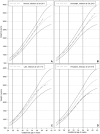Malaria and fetal growth alterations in the 3(rd) trimester of pregnancy: a longitudinal ultrasound study
- PMID: 23326508
- PMCID: PMC3543265
- DOI: 10.1371/journal.pone.0053794
Malaria and fetal growth alterations in the 3(rd) trimester of pregnancy: a longitudinal ultrasound study
Abstract
Background: Pregnancy associated malaria is associated with decreased birth weight, but in-utero evaluation of fetal growth alterations is rarely performed. The objective of this study was to investigate malaria induced changes in fetal growth during the 3(rd) trimester using trans-abdominal ultrasound.
Methods: An observational study of 876 pregnant women (398 primi- and secundigravidae and 478 multigravidae) was conducted in Tanzania. Fetal growth was monitored with ultrasound and screening for malaria was performed regularly. Birth weight and fetal weight were converted to z-scores, and fetal growth evaluated as fetal weight gain from the 26th week of pregnancy.
Results: Malaria infection only affected birth weight and fetal growth among primi- and secundigravid women. Forty-eight of the 398 primi- and secundigravid women had malaria during pregnancy causing a reduction in the newborns z-score of -0.50 (95% CI: -0.86, -0.13, P = 0.008, multiple linear regression). Fifty-eight percent (28/48) of the primi- and secundigravidae had malaria in the first half of pregnancy, but an effect on fetal growth was observed in the 3(rd) trimester with an OR of 4.89 for the fetal growth rate belonging to the lowest 25% in the population (95%CI: 2.03-11.79, P<0.001, multiple logistic regression). At an individual level, among the primi- and secundigravidae, 27% experienced alterations of fetal growth immediately after exposure but only for a short interval, 27% only late in pregnancy, 16.2% persistently from exposure until the end of pregnancy, and 29.7% had no alterations of fetal growth.
Conclusions: The effect of malaria infections was observed during the 3(rd) trimester, despite infections occurring much earlier in pregnancy, and different mechanisms might operate leading to different patterns of growth alterations. This study highlights the need for protection against malaria throughout pregnancy and the recognition that observed changes in fetal growth might be a consequence of an infection much earlier in pregnancy.
Conflict of interest statement
Figures

Similar articles
-
Factors associated with ultrasound-aided detection of suboptimal fetal growth in a malaria-endemic area in Papua New Guinea.BMC Pregnancy Childbirth. 2015 Apr 3;15:83. doi: 10.1186/s12884-015-0511-6. BMC Pregnancy Childbirth. 2015. PMID: 25881316 Free PMC article.
-
Prediction of small-for-gestational-age neonates at 35-37 weeks' gestation: contribution of maternal factors and growth velocity between 20 and 36 weeks.Ultrasound Obstet Gynecol. 2019 Apr;53(4):488-495. doi: 10.1002/uog.20243. Ultrasound Obstet Gynecol. 2019. PMID: 30779239
-
Contingent versus routine third-trimester screening for late fetal growth restriction.Ultrasound Obstet Gynecol. 2016 Jan;47(1):81-8. doi: 10.1002/uog.15740. Ultrasound Obstet Gynecol. 2016. PMID: 26365218
-
Diagnostic performance of third-trimester ultrasound for the prediction of late-onset fetal growth restriction: a systematic review and meta-analysis.Am J Obstet Gynecol. 2019 May;220(5):449-459.e19. doi: 10.1016/j.ajog.2018.09.043. Epub 2019 Jan 8. Am J Obstet Gynecol. 2019. PMID: 30633918
-
The World Health Organization fetal growth charts: concept, findings, interpretation, and application.Am J Obstet Gynecol. 2018 Feb;218(2S):S619-S629. doi: 10.1016/j.ajog.2017.12.010. Am J Obstet Gynecol. 2018. PMID: 29422204 Review.
Cited by
-
Relationships between infection with Plasmodium falciparum during pregnancy, measures of placental malaria, and adverse birth outcomes.Malar J. 2017 Oct 5;16(1):400. doi: 10.1186/s12936-017-2040-4. Malar J. 2017. PMID: 28982374 Free PMC article.
-
Maternal Malaria and Malnutrition (M3) initiative, a pooled birth cohort of 13 pregnancy studies in Africa and the Western Pacific.BMJ Open. 2016 Dec 21;6(12):e012697. doi: 10.1136/bmjopen-2016-012697. BMJ Open. 2016. PMID: 28003287 Free PMC article.
-
Factors associated with ultrasound-aided detection of suboptimal fetal growth in a malaria-endemic area in Papua New Guinea.BMC Pregnancy Childbirth. 2015 Apr 3;15:83. doi: 10.1186/s12884-015-0511-6. BMC Pregnancy Childbirth. 2015. PMID: 25881316 Free PMC article.
-
A cohort study of Plasmodium falciparum malaria in pregnancy and associations with uteroplacental blood flow and fetal anthropometrics in Kenya.Int J Gynaecol Obstet. 2014 Jul;126(1):78-82. doi: 10.1016/j.ijgo.2014.01.016. Epub 2014 Apr 3. Int J Gynaecol Obstet. 2014. PMID: 24792408 Free PMC article.
-
Ultrasound findings in pregnant women with uncomplicated vivax malaria in the Brazilian Amazon: a cohort study.Malar J. 2015 Apr 8;14:144. doi: 10.1186/s12936-015-0627-1. Malar J. 2015. PMID: 25889425 Free PMC article.
References
-
- Shulman CE, Marshall T, Dorman EK, Bulmer JN, Cutts F, et al. (2001) Malaria in pregnancy: adverse effects on haemoglobin levels and birthweight in primigravidae and multigravidae. Trop Med Int Health 6: 770–778. - PubMed
-
- Sullivan AD, Nyirenda T, Cullinan T, Taylor T, Harlow SD, et al. (1999) Malaria infection during pregnancy: intrauterine growth retardation and preterm delivery in Malawi. J Infect Dis 179: 1580–1583. - PubMed
-
- Steketee RW, Wirima JJ, Hightower AW, Slutsker L, Heymann DL, et al. (1996) The effect of malaria and malaria prevention in pregnancy on offspring birthweight, prematurity, and intrauterine growth retardation in rural Malawi. Am J Trop Med Hyg 55: 33–41. - PubMed
-
- Meuris S, Piko BB, Eerens P, Vanbellinghen AM, Dramaix M, et al. (1993) Gestational malaria: assessment of its consequences on fetal growth. Am J Trop Med Hyg 48: 603–609. - PubMed
Publication types
MeSH terms
LinkOut - more resources
Full Text Sources
Other Literature Sources
Medical
Miscellaneous

